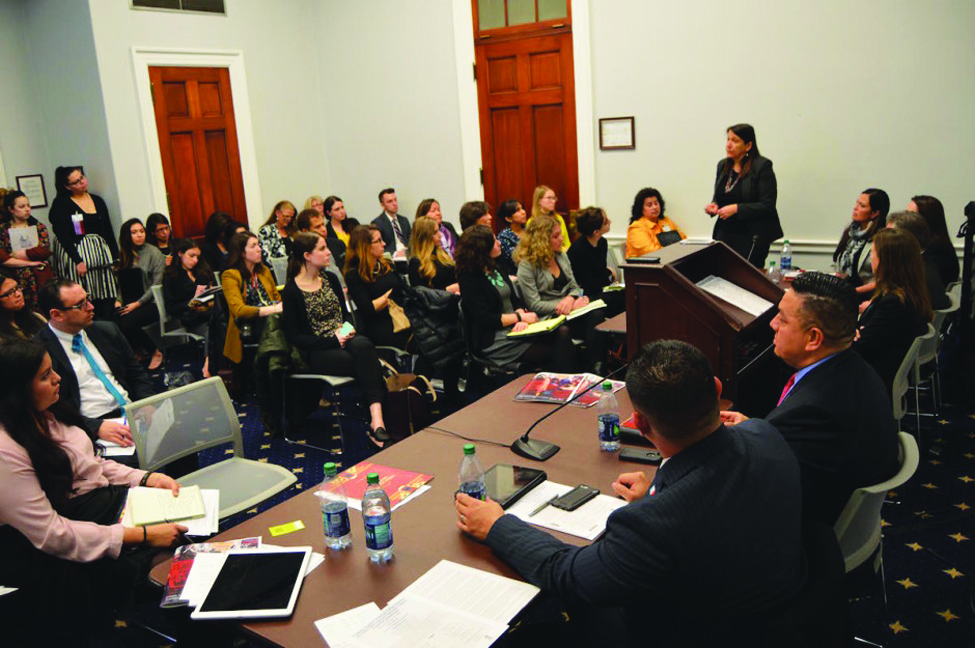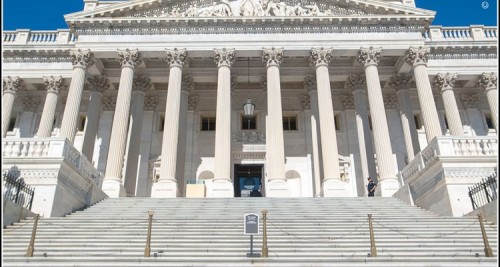Tag: Indian country
New colonizer in chief, same fight to protect our treaty rights
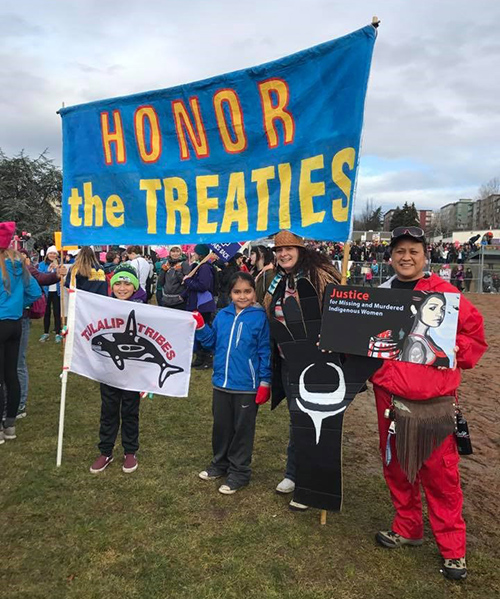
By Micheal Rios, Tulalip News
Donald Trump is President. For many in the Pacific Northwest and throughout Indian Country that is a gut-wrenching fact that will take some time to fully process. But it is a fact of life and we must adapt to a changing political climate like we have always done.
Local Lakota Activist and Marysville School District educator Matt Remle summed it up best when he released the following statement via Facebook on Inauguration Day. “People keep asking how we’re preparing for Trump. I keep responding ‘same way we prepare for any new colonizer in chief.’ Today is the same as yesterday as we continue to protect our lands, protect our water, protect our treaty rights, and fight for our children and future generations. #NoDAPL #BattleforMotherEarth.”
And that’s just it, we as Native people have always been fighting to protect our lands, water, treaty rights and future generations. There’s never been a pause to our fight, no one has ever said let’s take a break from resisting Western assimilation because of whoever happened to be in a local, state, or federal office. We honor our ancestors for their gifts of teachings to be strong, resilient and compassionate every day with every breath we take, just by being able to say we have endured and we are still here.
Now, Donald Trump is President and seemingly by the hour we are getting updates as to how he plans on weakening our treaty rights and depleting our resources. From signing executive orders to revive the Keystone XL and Dakota Access pipelines, to freezing Environmental Protection Agency grants and contracts, to potentially eliminating the Violence Against Women Act, there have been no shortages of offensive and egregious legislative actions being aimed at the tribes by the Trump Administration.
However, none of this should come as any shock or surprise. It’s all been completely in line with who we know him to be and what we know him to stand for. If anything, it’s surprising to see a President follow through on several key promises he made during his campaign as quickly as Trump is.
The moment Trump took office and became the 45th President, the White House website received a digital makeover to reflect the values and missions of the Trump Administration. As a result, White House policies on several high-stake issues were no longer available. One such issue was climate change, an issue that is critically important to the health of the world, but not so important to our President who routinely refers to climate change as “a hoax”.
What took the place of climate change policy is what’s titled An America First Energy Plan. The plan in its entirety is posted at the end of this article. There are some fascinating remarks made within this energy plan, such as “President Trump is committed to eliminating harmful and unnecessary policies such as the Climate Action Plan and the Waters of the U.S. rule.” Then there is this statement as well, “The Trump Administration will embrace the shale oil and gas revolution to bring jobs and prosperity to millions of Americans. We must take advantage of the estimated $50 trillion in untapped shale, oil, and natural gas reserves, especially those on federal lands that the American people own.”
“Trump’s plan is not a surprise – it’s consistent with what he has said throughout the campaign – a no holds barred approach to development of oil, natural gas, and coal, especially on federal lands and under federal waters,” says Libby Nelson, Tulalip Tribes Natural Resources Environmental Policy Analyst. “Climate change policy is seen as ‘harmful’ and there is no mention of ‘renewable energy’ (e.g., wind, solar) in Trump’s energy plan. Lifting environmental regulations, weakening the EPA, and increasing drilling may lead to more jobs and more revenue in the short term, but at what cost? At the cost of healthy, functioning and yes, economically valuable natural ecosystems that we need to sustain us long after the ‘shale oil revolution’. We will need to watch carefully as this new administration begins to translate its energy policy to proposed actions on the ground, and be prepared to act on behalf of the environment and tribal interests.”
So we will continue to watch and listen carefully as Trump continues to follow through on promises he made on his campaign trail because he did make these promises, but many didn’t listen. Now he’s doing exactly what he promised to do and there are a lot of progressives, our so-called allies, who are complicit in the legislation for policies like the pipelines going forward.
“I honestly believe that this monumental loss of faith in DC is a step in the right direction. No matter the President or who was Senator or Congressperson, DC has always been an obstacle, not an aid to our communities,” stated Native activist and renowned speaker Gyasi Ross via Facebook. “Our solutions are at home. Simple. That is shown by the fact that we have a home, a homeland – our communities were supposed to have been wiped out. Physically. Genocide. Extermination. But we weren’t wiped out and because of that we’re still able to improve, evolve and grow. Of course we can point to dysfunction, but that’s normal. That’s growing pains. We’re learning how to love ourselves again, to believe in ourselves again, to trust us and our own brilliance and spirituality. When we learn that fully, the solutions will be self-evident.
“Our solutions are not in DC and they never have been. If the cavalry was coming, they would have come a long time ago. Marshall would have stopped the Trail of Tears; Obama would have stopped DAPL. Neither one did. It was the thousands of organizers on the ground who did. No saviors. The only meaningful transformation or revolution that will really improve life for our communities will come from our communities, not an outside savior or great white father.”
Indeed, there must be a transformation and necessary resistance to defend against the likes of the Trump Administration and all other levels of government and establishment that seek to exploit the Earth and weaken our treaty rights. That resistance has been ongoing for the Tulalip Tribes because, again, organizations of all sorts have sought to lay claim to our lands, waters, and way of life long before Trump.
“The Tulalip Tribes has been legally fighting against any coal, oil, pipeline, or anything else that will ruin our Mother Earth and negatively impact our fresh water, our air quality, and our salt water,” says Theresa Sheldon, Tulalip Board of Director. “We will continue to oppose any policy or legislation that may make it easier for the federal government to exploit our lands and our way of life.
“As we go into a Republican Presidency with a Republican Congress, please do not lose faith. Treaty rights are not party based. The Point Elliott Treaty does not belong in the republican camp or democrat camp. Our issues are independent from party, but based in the fact that treaties are the Supreme Law of the Land as stated in the U.S. Constitution. We will continue to work with this new administration to educate them on our rights and we will fight hard to protect our rights as the Indigenous peoples of this country. May we stand together and support each other. Do not get distracted with the noise and rhetoric of two parties, but find balance in our teachings and in our way of life as our ancestors have always done.”
________________________________________________________
Within minutes of Donald Trump’s swearing in as 45th president of the Unites States, the pages on climate change, previously found on whitehouse.org, went dark. They were replaced with the following on a page dedicated to an energy plan.
An America First Energy Plan
Energy is an essential part of American life and a staple of the world economy. The Trump Administration is committed to energy policies that lower costs for hardworking Americans and maximize the use of American resources, freeing us from dependence on foreign oil.
For too long, we’ve been held back by burdensome regulations on our energy industry. President Trump is committed to eliminating harmful and unnecessary policies such as the Climate Action Plan and the Waters of the U.S. rule. Lifting these restrictions will greatly help American workers, increasing wages by more than $30 billion over the next 7 years.
Sound energy policy begins with the recognition that we have vast untapped domestic energy reserves right here in America. The Trump Administration will embrace the shale oil and gas revolution to bring jobs and prosperity to millions of Americans. We must take advantage of the estimated $50 trillion in untapped shale, oil, and natural gas reserves, especially those on federal lands that the American people own. We will use the revenues from energy production to rebuild our roads, schools, bridges and public infrastructure. Less expensive energy will be a big boost to American agriculture, as well.
The Trump Administration is also committed to clean coal technology, and to reviving America’s coal industry, which has been hurting for too long.
In addition to being good for our economy, boosting domestic energy production is in America’s national security interest. President Trump is committed to achieving energy independence from the OPEC cartel and any nations hostile to our interests. At the same time, we will work with our Gulf allies to develop a positive energy relationship as part of our anti-terrorism strategy.
Lastly, our need for energy must go hand-in-hand with responsible stewardship of the environment. Protecting clean air and clean water, conserving our natural habitats, and preserving our natural reserves and resources will remain a high priority. President Trump will refocus the EPA on its essential mission of protecting our air and water.
A brighter future depends on energy policies that stimulate our economy, ensure our security, and protect our health. Under the Trump Administration’s energy policies, that future can become a reality.
Contact Micheal Rios at mrios@tulalipnews-nsn.gov
Standing Room Only at Congressional Briefing on the Impact of VAWA 2013 in Indian Country
February 24, 2016, Press Release: National Indigenous Women’s Resource Center, www.NIWRC.org
Washington, D.C. — More than 100 people accepted the invitation to attend a congressional briefing, Violence Against Women and Implementation of VAWA 2013 Special Domestic Violence Criminal Jurisdiction held February 23, 2016 in Washington, D.C.
“VAWA was a major step but it was just the beginning to restoring to Indian tribes – sovereign nations – the authority to protect women,” said Congressman Xavier Becerra. “I want to thank those tribes who are implementing tribal jurisdiction over non-Indians committing domestic violence on tribal lands because we can now talk about real successes. Now we have cases of Native women who have had their rights defended.”
The 2013 Violence Against Women Act affirmed tribes’ ability to exercise special domestic violence criminal jurisdiction (SDVCJ) over non-Indian defendants within Indian country for domestic or dating violence against Native women, and violations of protection orders. The briefing provided updates on tribal implementation of this life-saving legislation.
“Why was this provision needed?” asked Terri Henry, the moderator of the briefing and the former chairwoman of the Eastern Band of Cherokee Indians and current Co-Chair of the National Congress of American Indians Task Force on Violence Against Women. “Because the rates of violence perpetrated against Native women showed that 6 in 10 Native women will be victims of domestic violence. And 1 of 3 Native women will be raped in their lifetime, many of which are domestic violence related.”
The briefing was cosponsored by the National Indigenous Women’s Resource Center (NIWRC), the Indian Law Resource Center (ILRC), and the National Congress of American Indians (NCAI). The honorary congressional co-hosts were U.S. Representatives Louise M. Slaughter, Betty McCollum, Gwen Moore, and Xavier Becerra.
“But, when you look at national statistics for Native women, what is lost in translation is the complexity of the criminal justice system and understanding that these crimes are perpetrated at the local level. In the case of Native women, these crimes are committed at the local, tribal level,” shared Ms. Henry. “Our reality is that our tribal lands have become safe havens for perpetrators.”
As of January 1, 2016, eight tribes have implemented special domestic violence criminal jurisdiction over non-Indians under VAWA 2013. Together, the tribes have made 44 SDVCJ arrests, resulting in 18 guilty pleas, 5 referrals for federal prosecution, 1 acquittal by jury, 12 dismissals, with 6 cases pending.
The Pascua Yaqui Tribe began exercising SDVCJ on February 20, 2014, as part of the DOJ Pilot Project. “We knew these offenses were occurring for many years and all we could do was drive the abuser to the edge of the reservation. We found that the non-Indian defendants had a long history of violence and were repeat offenders, some with criminal convictions and outstanding felony warrants,” said Alfred Urbina, Attorney General, Pascua Yaqui Tribe.
Since implementing SDVCJ, the tribe has made 26 SDVCJ arrests involving 20 separate offenders, resulting in 6 guilty pleas, 4 referrals for federal prosecution, 1 acquittal by jury, and 10 dismissals. Pascua Yaqui reports that since it began implementing SDVCJ, cases involving non-Indians have made up 25% of the tribe’s domestic violence caseload.
“The 16 offenders investigated in the initial year accounted for 86 contacts with just Pascua Yaqui law enforcement before and after passage of VAWA 2013 and not counting state contacts. The offenders included African American, Asian, Hispanic and Caucasian men and one woman,” said Oscar “OJ” Flores, Chief Prosecutor of the Pascua Yaqui Tribe.
The Tulalip Tribes began exercising SDVCJ on February 20, 2014, as part of the DOJ Pilot Project. As of February 1, 2016, the Tribes had 11 SDVCJ arrests involving 9 defendants, resulting in 6 guilty pleas, 1 federal guilty plea, 2 dismissals, and 2 cases pending. The defendants have had a combined number of 109 contacts with Tulalip Tribal Law Enforcement since 2008.
“Non-Indian offenders had the feeling they could do what they wanted to because there was no way they would be prosecuted. We could call county law enforcement but their response was very long or they would not come at all,” said Glen Gobin, Vice Chairman of the Tulalip Indian Tribes. “Now the tribe can prosecute non-Indian offenders but the jurisdiction is limited to certain crimes, it does not protect victims of stranger rape, and does not protect children or other family members.
“I am here to ask for your help to protect our children. The law today does not allow our tribe to charge crimes by non-Indians against children who are present or involved. We need the jurisdiction to protect our children,” said Theresa Sheldon, Councilwoman, Tulalip Tribes.
In response to a question asking what members of Congress can do to help in the coming weeks, Virginia Davis of the National Congress of American Indians responded, “The most critical support needed right now is tied to resources for Indian tribes to enhance their response and implement this life-saving provision. Most significant is tribal access to the Crime Victim’s Fund which is the main source of federal funding to crime victims. These funds do not currently reach Indian country well because there is no dedicated funding stream for Indian tribes. This could be fixed in the appropriations process. Last year the Senate included money from the Crime Victim’s Fund in the CJS bill but the House did not. In the ultimate bill that was passed it was not included. We are hoping for your support over the coming months.”
“I want to thank all of you implementing the hard fought legislation won under the Violence Against Women Act. You have learned from your cases prosecuting non-Indians. We knew that VAWA needed to protect all women,” said Congresswoman Gwen Moore. “We need to expand the jurisdiction over children, sexual assault and other crimes connected to domestic violence. Tribal women certainly should have the protection of their law enforcement and know they can live safe in their community.”
Tribes scramble to avoid $1 million in fines under Affordable Care Act
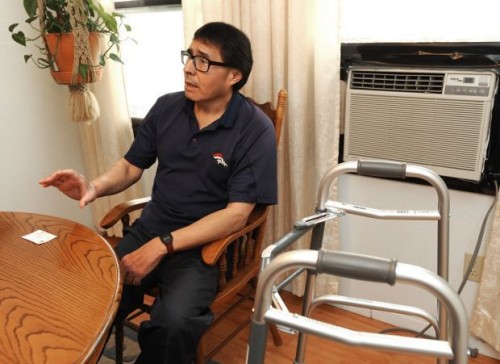
Photo/Larry Mayer, Gazette staff
By Tom Lutey, The Missoulian
BILLINGS – Montana’s Indian tribes, which until recently thought the Affordable Care Act would pass them by, could face fines exceeding $1 million for not offering insurance to employees.
Beginning in 2016, businesses with 50 or more full-time workers will have to offer at least a minimum amount of health insurance to employees. Those who don’t comply face tax penalties, and that includes tribal governments.
The requirement has been a surprise to tribes, said George Heavy Runner, Blackfeet Insurance Services health and wellness coordinator. As individuals, American Indians have the option of choosing not to follow Affordable Care Act rules. Many assumed tribal governments, which are sovereign, had that same option.
“We thought this was a ship kind of passing us by,” Heavy Runner said. “But it’s not just a ship passing through the night. We have been identified in this legislation, just not where we thought we would be.”
Tax penalties facing the Blackfeet Tribe for not complying could be as high as $1.1 million. Crow Tribal Chairman Darrin Old Coyote said the size of the fee depends on how many people a tribal government employs.
“If we don’t do the mandate, we’re going to be fined for the number of employees we have, and that number could be up to $1.5 million,” Old Coyote said. “We pay federal tax, and our employees pay federal tax and so we’re part of the large employer mandate.”
The tribes can avoid the fees by offering the insurance to their workers. Old Coyote said the Crow have hired a benefits manager to do just that.
***
The change caught tribes off-guard because American Indians by treaty receive health care via the Indian Health Service on reservations. IHS is much maligned by tribal members for not providing adequate health care and for not covering services by specialists outside the IHS program.
Because IHS is limited, tribal members who work for their government would benefit from having other health care, Old Coyote said. The challenge is having a health care plan to offer by next year.
Suing to get off the employer mandate has already been tried. In February, Wyoming’s Northern Arapaho Tribe failed to convince a federal judge to block the employer mandate. The Northern Arapaho argued that subjecting tribes to the employer mandate was an oversight that overlooked treaty rights related to Indian health care, while also stating that tax credits and benefits granted to Indians under the Affordable Care Act would be denied.
Earlier this month, U.S. Sen. Steve Daines, R-Mont., and U.S. Rep. Ryan Zinke, R-Mont., announced a bill to exempt tribes from the employer mandate. Daines called the mandate a job killer for tribal governments, who wouldn’t hire as many employees if they had to pay significant penalties.
Other sponsors of the bill, such as Republican Sen. John Thune, of South Dakota, said it was unfair to exempt individual tribal members and not exempt tribal governments as well.
However, exempting tribes from the employer mandate won’t help the nagging problems with Indian health care, said a representative for Sen. Jon Tester, D-Mont.
“This bill does nothing to solve the underlying problem, which is crisis-level health disparities among Native Americans,” said Marnee Banks. “If we are serious about increasing access to quality health care in Indian Country, we will expand Medicaid and adequately fund the Indian Health Service.”
***
IHS spending on Indian patients was $2,741 per person in 2013, according to the National Congress of American Indians, which asserts that IHS is severely underfunded. Medicaid spending, by comparison was $5,841.
The state of Montana is awaiting federal approval of the state’s plan to begin offering Medicaid to Montanans earning up to 138 percent of the federal poverty level.
Medicaid expansion would extend benefits to as many as 11,000 tribal members over the next four years, said Jon Ebelt of Montana’s Department of Public Health and Human Services. The program would benefit tribal health care in general, Ebelt said.
“Medicaid expansion revenue will be critical for building health infrastructure, expanding the workforce, and keeping health care providers in tribal communities,” Ebelt said. “Medicaid revenues will bring new funds to the programs and further investment in the Indian health system infrastructure and workforce. This is an opportunity to provide more health care services, create more jobs and employ more Native Americans in tribal communities.”
Old Coyote said he’s concerned that state benefits representatives won’t be able to clearly explain the expanded Medicaid program to some Crow Indians who speak Crow as their primary language. He’s asked the state to provide a benefits representative who is fluent in Crow.
Ebelt said the state is able to provide translation assistance if necessary and in determining an outreach plan with members of the Indian Health Service at Crow Agency.
Tribal Labor Sovereignty Act moves forward after markup session
By Kim Morrison, World Casino News
H.R.511 gains momentum as members of the House Committee on Education and the Workforce attend the July 22, 2015 markup session which was packed with members of the National Indian Gaming Association in Washington, D.C., for a legislative summit.
The Act which exempts tribes and their casinos from the National Labor Relations Act (NLRA), the Tribal Labor Sovereignty Act was passed on Wednesday at the short markup session on Capitol Hill.
According to the Chairman of the Committee, Rep. John Kline (R-Minnesota) who introduced the bill, “it’s not about big business versus big labor and it’s not about Republican versus Democrat.”
Kline went on to add that “the bill we are considering today is about whether Native Americans should be free to govern employee-employer relations in a way they determine is best for their workplace.”
In what Rep. Todd Rokita (R-Indiana) described as a “bipartisan, commonsense proposal that will provide legal certainty to the Native American community,” the Act would exempt tribes and their casinos from the National Labor Relations Act (NLRA), and prohibit the National Labor Relations Board from asserting jurisdiction at those businesses.
Rokita also went on to state that the Act would give authority back to tribal leaders and end the National Labor Review Board’s (NLRB) overreach, and restore the standard that was in place long before the National Labor Relations Board made the misguided decision to change course. An amendment in the nature of a substitute to clarify that tribal governments are also exempt from the NLRA, was offered by Rokita.
Opposition to the Sovereignty Act was voiced by the only Democrats present, Rep. Mark Pocan (D-Wisconsin), Rep. Joe Courtney (D-Connecticut) and Rep. Ruben Hinojosa (D-Texas), who accused Republicans and their allies of using tribal sovereignty as a smokescreen to attack the NLRB.
Representative Pocan accused proponents of the bill, such as the U.S. Chamber of Commerce, of endorsing the bill in an attempt to help destroy the NLRB rather than support for the sovereignty of the tribes.
The three also noted that most employees of tribal casinos are non-Indians and argued that the bill will degrade labor standards Indian Country.
Although it hasn’t been taken up by the full Senate, on June 10th the Senate Indian Affairs Committee approved S.248, its version of the bill which is gaining traction among lawmakers from both parties.
At that legislative summit which opened Tuesday on Capitol Hill (hosted by the National Indian Gaming Association (NIGA)), Sen. Heidi Heitkamp (D-North Dakota) stressed that every conversation about gaming should begin by stating that gaming is not something that the federal government authorized you to do, but a sovereign right.
She added that, “If the Indian Gaming Regulatory Act went away tomorrow, you would still be able to conduct gaming,”
Exemption from the NLRA has been sought after by the tribes ever since a 2004 ruling in which the NLRB asserted jurisdiction over Indian Country for the first time in decades, but efforts to address the issue ran into serious opposition from Democrats and their labor union allies at that time.
Since that 2004 ruling, tribes have won support from key Democrats by pitching the issue as one of parity with other governments, and with Republicans in control of the House and Senate, the bill has moved quickly in the 114th Congress.
The bill would resolve uncertainties like the one that arose in early June when the NLRB declined to assert jurisdiction at the WinStar World Casino and Resort, a casino owned by the Chickasaw Nation of Oklahoma, citing the tribe’s treaty-protected right to self-governance.
Less than a week later, the 6th Circuit Court of Appeals backed the NLRB’s jurisdiction over the Little River Casino and Resort, a casino owned by the Little River Band of Ottawa Indians in Michigan, and three weeks later, expressing serious doubts about the application of the NLRA in Indian Country, the same court rejected the treaty claims of the Saginaw Chippewa Tribe, also in Michigan.
The U.S. federal law that establishes the jurisdictional framework that governs Indian gaming, the Indian Gaming Regulatory Act (IGRA), has been a source of extensive controversy and litigation since it was passed in 1988.
Indian tribes set to begin marijuana sales
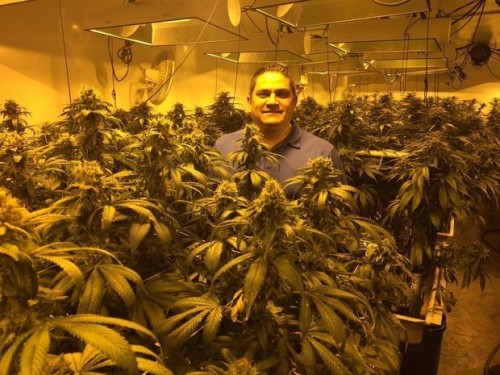
PHOTO COURTESY OF TONY REIDER — Handout
BY ROB HOTAKAINEN, Sun Herald
WASHINGTON — Tourists soon may be able to go to a South Dakota Indian reservation, buy a cigarette-sized marijuana joint for $10 to $15 and try their luck at the nearby casino.
In December, the Flandreau Santee Siouxexpect to become the first tribe in the nation to grow and sell pot for recreational use, cashing in on the Obama administration’s offer to let all 566 federally recognized tribes enter the marijuana industry.
“The fact that we are first doesn’t scare us,” said tribal president Anthony “Tony” Reider, 38, who’s led the tribe for nearly five years. “The Department of Justice gave us the go-ahead, similar to what they did with the states, so we’re comfortable going with it.”
The tribe plans to sell 60 strains of marijuana. Reider is hoping for a flock of visitors, predicting that sales could bring in as much as $2 million per month.
“Obviously, when you launch a business, you’re hoping to sell all the product and have a shortage, like Colorado did when they first opened,” he said.
Other tribes have been much more hesitant.
“Look at Washington state, where marijuana’s completely legal as a matter of state law everywhere, and you still have tribes adhering to their prohibition policies,” said Robert Odawi Porter, former president of the Seneca Nation of New York.
It comes as no surprise to Washington state Democratic Rep. Denny Heck, who says he works on tribal issues every day.
“Not once has anybody ever brought up that they wanted to go down this track,” he said.
Heck speculated on one possible reason: “We’re all aware of the painful history of alcoholism in Indian Country.”
Tribes won the approval to sell pot in December, when the Justice Department said it would advise U.S. attorneys not to prosecute if tribes do a good job policing themselves and make sure that marijuana doesn’t leave tribal lands.
But federal prosecutors maintain the discretion to intervene, a worrisome prospect for many.
“This administration is very pro-tribes, very supportive. What if the next one isn’t?” asked W. Ron Allen, chairman of the Jamestown S’Klallam Tribe in Washington state.
He said many of the state’s 29 tribes also want assurances from federal officials that they won’t lose millions of dollars in grants and contracts if they sell a drug banned by Congress.
“We’re not getting definitive answers back,” Allen said. “There’s a number of tribes that are very aggressively looking into it and trying to sort through all the legal issues. The rest of us are just kind of on the sidelines watching.”
Many tribal officials took note earlier this month when federal authorities seized 12,000 marijuana plants and more than 100 pounds of processed marijuana on tribal land in Modoc County, Calif.
Federal authorities said they raided the operation because the tribes planned to sell the pot on non-reservation land.
“That’s a warning shot to Indian County that this isn’t carte blanche to do whatever you want, even in a place like California,” said Blake Trueblood, director of business development for the National Center for American Indian Enterprise Development, based in Arizona.
Trueblood said marijuana could give tribes an economic boost, much like gaming. He said tribes will have the best opportunities in states such as Florida and New York, where demand for pot is high but the drug has not been legalized for recreational use by state voters.
“Ultimately, I think you’ll see legal marijuana in every state,” Trueblood said. “I think that’s fairly inevitable, even in very conservative places like Florida.”
Reider said his tribe plans to sell both medical and recreational marijuana. Minors will be allowed to consume pot if they have a recommendation from a doctor. Under a tribal ordinance passed in June, adults 21 and over will be able to buy one gram of marijuana at a time for recreational use, no more than twice a day.
“We really don’t want the stuff getting out to the street,” Reider said. “So we’re going to have like a bar setting where they’ll be able to consume small amounts while on the property.”
Kevin Sabet, president of the anti-legalization group Smart Approaches to Marijuana, said the California raid shows that it’s still “an extremely risky venture” for any tribe to start selling marijuana. And he said pot sales would fuel more addiction.
“If we think alcohol has had a negative effect on young people on tribal lands, we ain’t seen nothing yet,” Sabet said.
As part of his homework, Reider said, he traveled to Colorado, the first state to sell recreational pot last year. He said he does not smoke marijuana but has concluded that it’s safer than alcohol, citing the behavior he witnessed at the Cannabis Cup, a marijuana celebration held in Denver in April.
“It was a peaceful environment,” he said. “Everybody was overly friendly, overly talkative to each other and respectful of each other. Where if you go to a concert where there’s a lot of alcohol, you typically see fights and arguments.”
Reider said the tribe plans to begin growing 6,000 marijuana plants in October and is renovating a bowling alley to house a new consumption lounge that will include four private rooms. He said the tribe may consider allowing marijuana consumption in its casino in the future.
Reider acknowledged that it’s “kind of an awkward feeling” to start selling pot, but he figures the tribe is well-equipped.
“When we started looking into it, it’s comical at first, but then you realize it’s an amazing business,” he said. “It’s highly regulated, and we’re used to the regulation from operating our casino. We’ve got security and surveillance.”
Reider said profits from pot sales will be used to help tribal members. He said that could include the construction of a facility for those addicted to alcohol, prescription drugs or methamphetamine.
“We don’t have a recovery treatment center on the reservation right now,” Reider said. “Potentially we could look to fund one of those operations, and not just for marijuana addiction.”
Why Obesity and Heart Disease Hit Harder in Indian Country
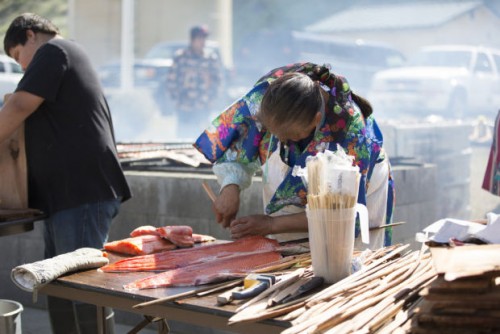
And how to fix it.
By Francie Diep, Pacific Standard
The Navajo Nation covers 27,413 square miles. Serving that entire area, the territory has just 10 grocery stores. This means that, in order to get fresh, affordable produce, some Navajo Nation residents must drive at least 155 miles round-trip, according to one recent study.
This makes the Navajo Nation, like many other American Indian reservations, a food desert—a region in the United States where residents can’t easily buy fresh, healthy, affordable food. (Because of their setting, these food deserts are unlike those that normally show up in the news, which tend to be in urban centers.) In recent years, American public health researchers and policy experts have done a lot to document the effects of food deserts on people’s health, and to suggest solutions. Yet, in all that talk, nothing quite seemed like it would work for the people Crystal Echohawk and Janie Simms Hipp serve. “The policy levers were off,” Hipp says. “They were not a good fit because of the uniqueness of Indian Country.”
Hipp is an agriculture lawyer who directs a research institute at the University of Arkansas School of Law. Echohawk runs her own consulting firm in Colorado that advises non-profits working on American Indian issues. Together, they advocate for American Indians to gain better access to healthy food, which would in turn reduce rates of obesity, diabetes, and other diet-related ills that run rampant in the Native American population as a whole. Over 80 percent of American Indian and Alaska Native adults are overweight or obese; about half of American Indian children are at an unhealthy weight; and it’s estimated 30 percent of American Indians and Alaska Natives have pre-diabetes. Compare those statistics to American adults in general, two-thirds of whom are overweight or obese, and 27 percent of whom are estimated to have pre-diabetes.
“Oftentimes, when conversations are had with policymakers or philanthropy or public health, people just turn away and say, ‘We don’t know where to start. The problems are too big for us to solve.’ But there’s no shortage of opportunity for real change.”
Conventional fixes probably won’t work. But Echohawk and Hipp have ideas for what will. Together with lawyer-activist Wilson Pipestem, they put together a report for the American Heart Association about how to address the unique burden of diet-related disease that the U.S.’s indigenous people carry. “I think, oftentimes, when conversations are had with policymakers or philanthropy or public health, people just turn away and say, ‘We don’t know where to start. The problems are too big for us to solve,'” Echohawk says. “But there’s no shortage of opportunity for real change.”
Pacific Standard recently talked over the phone with Echohawk and Hipp about what makes it hard to stay healthy while living on reservations and trust lands—what’s collectively called Indian Country—and how a local food movement and cultural programs can make it easier:
What are some examples of policy ideas for reducing obesity that weren’t good fits for Indian Country?
Janie Hipp: I’d served for six years or so with the Bush and Obama administrations at the U.S. Department of Agriculture. I was always struck when policy, at the national level, was really bearing down on food deserts. They talked about encouraging retail food outlets to carry more healthy food products or fresher produce. That’s great, but if you have no retail food outlet, then you’re actually talking about a whole different policy arena that you need to wrap your head around.
Crystal Echohawk: There’s just the assumption that people already had outlets, that they were in urban centers. There’s also the lack of understanding of tribes as sovereign nations and their ability to institute a level of policy change over their tribal citizens. Now, a lot of the policy change that is being advocated is at the state level. But when we really look at the biggest levers of change in Indian Country, we look at the level of tribal government and we also look at federal because of the government-to-government relationship that tribes have with the federal government.
I saw that the Navajo Nation this year instituted a tax on junk food. It also made fresh fruits and vegetables tax-free. I can’t imagine a state doing that. New York City tried to institute a sugary-drinks tax and it failed.
CE: There’s immense opportunity for real change in Indian Country. What Navajo Nation did, I think, is just one example. There are just so many more opportunities aside from a tax.
What’s one of your favorite ideas for improving healthy food access in Indian Country?
JH: The vast majority of the foods that are raised for human consumption on our reservations leave the borders of the reservation. If the levers are pulled in such a way that feeding people healthy, local food comes first, before you feed folks outside of those reservation boundaries—you can do both—then we are within reach of having a major shift in our health. And oh, by the way, [by selling locally grown food locally] we also can build strong rural and remote economies.
Why does all the food leave?
JH: What is lacking in all rural communities—it’s not just Indian Country, but the lack is more profound—is the infrastructure necessary to do the harvesting, grading, packing, storage, freezing, all of those things that allow you to store and move food around more locally. Re-building those infrastructure pieces, or building them outright, is an important piece that can’t be ignored.
What’s wrong with growing food on tribal land and having that shipped out, and then having something else shipped in, instead?
JH: Being able to retain as much healthy local food around our communities as possible is going to lead to fresher produce being available to us. On the meat side, that’s been a phenomenon for years, where livestock is raised on our reservations, but they leave the reservation boundaries and, in many cases, never return. Or they make a circuitous route across the U.S. before they get back. Think about the cost associated with that. All you have to do is go into a grocery store close by any of our remote reservations and you will noticeably see the cost of food is much higher, and that’s not even talking about Alaska.
Why do you think American Indians have higher rates of obesity and diabetes than Americans in general?
CE: Poverty is a root cause. It’s a lot cheaper to go to McDonald’s and order stuff off the Dollar Menu than it is to go in and buy fruits and vegetables in a store when you’re looking at many families that are surviving on one paycheck and feeding a dozen people.
Another important component is how we’re addressing historical trauma within Native American people. There’s been increasing research out there linking trauma to health disparities. When you look at the history regarding Native Americans, of forced removal, of genocide, the boarding schools, it’s layer upon layer of trauma that Native American people, over generations, have sustained
Senate Adopts Thune Provisions to Address Youth Suicide
By Ryan Wrasse, Kelo.com
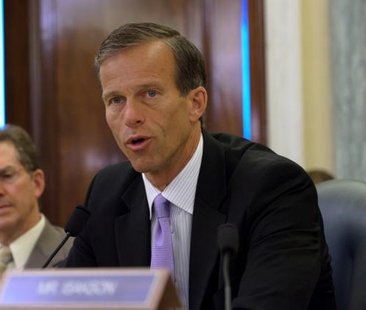
WASHINGTON (KELO AM) – U.S. Sen. John Thune (R-S.D.) applauded the Senate’s adoption of his amendments to the Every Child Achieves Act (ECAA), a bill that would reduce federal interference in education, and put governors, school boards, parents, and teachers back in charge. Thune’s amendments would require the secretary of education to coordinate with other federal agencies to report on efforts to address youth suicides in Indian Country and expand the use of Project School Emergency Response to Violence (Project SERV) funds to include preventative efforts against youth suicide and other school violence.
“There is no greater tragedy for a family than losing a child, sibling, or friend, especially to suicide,” said Thune. “Sadly, according the Indian Health Service, suicide is the second leading cause of death for Indian youth in Indian Health Service areas, with a death rate four times the national average. While there is a wide range of known factors that contribute to youth suicide, I think it’s important for us to get a better understanding of how we can better address both prevention and response to suicide in Indian Country.”
Thune’s amendment would require, within 90 days from the date of enactment, the secretary of education to coordinate with the secretary of interior and secretary of health and human services to report on a variety of information, including:
- The federal response to the occurrence of high numbers of student suicide in Indian Country
- A list of federal resources available to prevent and respond to student suicide outbreaks, including the availability and use of tele-behavioral health
- Interagency collaboration efforts to streamline access to programs, including information on how the Departments of Education, Interior, and Health and Human Services work together on program administration
- Any existing barriers to timely program implementation or interagency collaboration
- Recommendations to improve or consolidate existing programs or resources
- Tribal feedback to the federal response
The Senate also adopted Thune’s amendment that would expand the authorized use of Project SERV funds to include initiating or strengthening prevention activities in cases of chronic trauma or violence, such as the suicide crisis in Indian Country or gang violence in schools.
Local educational agencies and institutions of higher education seeking approval to initiate or strengthen prevention activities would be required to:
- Demonstrate a continued disruption or a substantial risk of disruption to the learning environment that would be addressed by such activity
- Provide an explanation of proposed activities designed to restore and preserve the learning environment
- Provide a budget and budget narrative
Such requests would be subject to the discretion of the secretary and the availability of funds.
Thune also introduced amendments to ECAA that would exempt K-12 schools and higher education institutions from Obamacare’s employer mandate, allow Tribal Grant Schools to participate in the Federal Employees Health Benefits program, and provide parity for tribal colleges to compete for certain funding sources. These amendments were not adopted during the Senate’s consideration of ECAA.
Congress Holds Hearing On Native American Juvenile Justice
By Laurel Morales, Fronteras
The U.S. Senate Committee on Indian Affairs held a hearing July 15 on juvenile justice in Indian Country. It comes on the heels of three recent reports that conclude the system is failing Native American youth.
Native American youth suffer staggeringly high rates of substance abuse, exposure to violence and suicide. When those kids get in trouble, many tribes don’t want them locked up. The senators asked the panel for steps Congress could take to improve the juvenile justice system.
Darren Cruzan, BIA deputy director of justice services, said courts both on and off the reservation need to assess each case individually to decide what kind of help that child needs.
“We are working on an assessment tool that will better help courts, when offenders do come into the system, point them toward the services they need,” Cruzan said. “It may be anger management. It may be suicide ideations. It may be drug or alcohol treatment.”
University of Nevada Las Vegas professor Addie Rolnick said assessments are great, but more needs to be done.
“You can do all the screening in the world and you can do it well but if you have nothing to do with those kids after you screen them,” Rolnick said. “You could find out all the kids, 90 percent of the kids, were suffering from mental health issues. But if there was no where to put them it wouldn’t matter that you screened them.”
Rolnick called for funding of prevention efforts, diversion programs and other alternatives to jail. She also suggested amendments to federal juvenile justice laws that include tribes.
Obama unveils program to connect low-income areas with high-speed internet
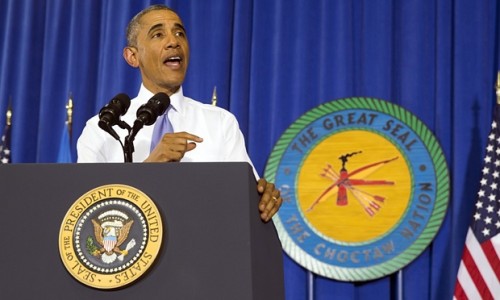
ConnectHome will launch in 27 cities and the Choctaw Nation, from where the president announced the initiative: ‘The internet is not a luxury – it’s a necessity
By Sabrina Siddiqui, The Guardian
Barack Obama on Wednesday paid a visit to one of the largest Native American tribes in the United States to emphasize the importance of expanding economic opportunity.
The president chose the Choctaw Nation area, an Indian reservation that spans roughly 11,000 miles across south-eastern Oklahoma, to launch an initiative that would increase access to high-speed internet in low-income households.
“The internet is not a luxury – it’s a necessity,” Obama said. “You cannot connect to today’s economy without having access to the internet.”
The pilot program, called ConnectHome, will serve as part of the Obama administration’s efforts to bridge the gap that leaves many communities – especially in low-income and rural areas – without broadband access.
The plan will launch in 27 cities, in addition to the Choctaw Nation, and will initially provide internet access to 275,000 low-income households and nearly 200,000 children, the White House said.
Citing an achievement gap, Obama said there were many consequences to not having internet access. It might begin with something as basic as young people not being able to complete their homework, the president said, and translate to a math and science gap and later an economic gap.
“In an increasingly competitive global economy, our whole country will fall behind,” Obama said.
The trip marks the second time Obama has directed attention at the Choctaw Nation, the third-largest Native American tribe in the United States. Last year, he included the Choctaw Nation among five so-called Promise Zones – an initiative directed at impoverished areas under which the federal government would partner with businesses and local governments to offer tax incentives and grants as part of a broader effort to reduce poverty.
Following its Promise Zone designation, the Choctaw Nation has received $58m in federal aid that has been used to expand educational opportunities and access to healthcare facilities.
Approximately 23% of individuals residing in the Choctaw Nation live below the poverty line – in some of its communities, the poverty rate is nearly 50%. The national poverty rate was 14.5% in 2013, according to the US census bureau.
“We’ve got a special obligation to make sure that tribal youth have every opportunity to reach their full potential,” Obama said in his remarks on Wednesday. “A child’s ability to succeed should not be based on where she lives, how much money her parents make. That’s not who we are as a country.”
Before his speech, Obama met with youth from the Choctaw Nation, Cherokee Nation, Muscogee (Creek) Nation and Chickasaw Nation.
Obama has stressed the need to improve the conditions of Native Americansbefore, particularly with respect to jobs and education.
“Native Americans face poverty rates far higher than the national average – nearly 60% in some places. And the dropout rate of Native American students is nearly twice the national rate,” he wrote in an op-ed last year. “These numbers are a moral call to action.”
Obama penned that op-ed ahead of a visit last June to the Standing Rock Sioux Tribe, located in both North and South Dakota. The president characterized the visit as an emotional one that he said left him and first lady Michelle Obama “shaken, because some of these kids were carrying burdens no young person should ever have to carry”.
“It was heartbreaking,” Obama added at the time.
According to a fact sheet released by the administration, the Obama administration is on track to meet its promise that 99% of K-12 students can use the internet in their classrooms and libraries by 2017.
“There are places where internet access can be a game-changer, but where service has not kept up,” Jeff Zients, director at the White House National Economic Council, told reporters ahead of Obama’s trip. “That’s especially true in schools … Students in every community need fast and reliable internet to get ahead and learn.”
According to an analysis by the President’s Council of Economic Advisers, released on Wednesday, nearly two-thirds of households among the lowest-income quintile of Americans owns a computer, but less than half have a subscription with an internet service provider.
The report further found a “strong positive association” between median income and use of the web. Minorities were disproportionately affected, according to data compiled in 2013: black and Hispanic households lagged 16 and 11 points behind white households in having internet access, while Native American households were 19 points behind white households.



